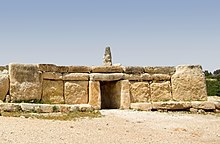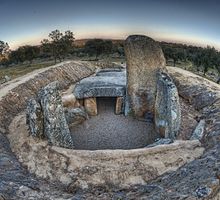Megalithism
The term megalithism comes from the Greek words mega (μεγας) large and lithos (λιθος), stone. Although in a literal sense we can find megalithic constructions all over the world, from Japan to the giants of Easter Island, in a strict sense many authors only call megalithism the cultural phenomenon whose focus is located in the western Mediterranean and Atlantic Europe, which It begins at the end of the Neolithic and lasts until the Bronze Age and is characterized by the realization of various constructions made with large blocks of stone with little hewn and called megaliths. Thus, according to these researchers, when talking about megalithism, Cyclopean constructions corresponding to other cultural dynamics such as those of the Aegean Bronze, the Balearic Islands or the Sardinian should not be included, much less those of Egypt or Polynesia.
There are large megalithic monuments scattered throughout much of Western Europe, but the most important foci are in Britain, southern England and Ireland, and southern Spain and Portugal.
This phenomenon is essentially identified with the construction of monumental tombs of the dolmen type (in Breton stone table), inside which the deceased of a group of people were buried successively, carefully separating the bones of the previous deceased (collective burials). The dolmens can be simple or corridor, gallery, or cistas, and most of them were initially covered by a mound of earth or stones, which nowadays has mostly disappeared. In addition to the dolmens, within the megalithic context, you can find another non-funerary construction typology called menhir, a monolith sunk into the ground that can appear isolated or forming alignments (in Carnac) or circles (henges, as in Stonehenge). There are also many cromlechs, more or less large stone circles that surrounded the mound of a dolmen, tholoi, false dolmens and artificial caves.
Building process
The construction process of a megalith began in the quarry where the large blocks of stone were extracted. From there they were transported (1) on trunks and branches to the place chosen for the erection of the monument. Here the vertical blocks were dropped into a narrow previously excavated hole (2) and then adjusted until they were in a vertical position, after which the hole was backfilled to fix them firmly. In the case of the menhirs, the process was finished, but for the erection of a dolmen, the most difficult task continued, consisting of placing the horizontal block or blocks. For this, embankments were made on both sides of the orthostats, until reaching the same height as these (and very probably the space between the two walls was also filled with earth, which was later emptied). The horizontal block (3) was transported along these embankments until it was correctly positioned, after which everything was covered with earth, giving rise to the burial mound (4). Such a construction hypothesis has been verified in practice by several research teams, including that of J.P. Mohen, who in 1979 built a dolmen in France using two hundred men and whose upper slab weighed 32 tons.
Studies carried out in Wessex, in the south of England, showed that building the final phase of Stonehenge required some 30 million man hours, carried out by a workforce drawn from all over the region. The great burial mound at Silbury Hill, in the same region, took 18 million hours and was raised in just two years, according to its excavator. Each of the minor henges in Wessex involved around a million hours of work, or what would be the same, 300 people working a whole year.
Development
Although it was initially thought that the simplest monuments were necessarily older and that they became more complex over time, it is now known that this was not always the case: in Brittany they were built from the 5th millennium BC. C. large megalithic groups, while in the II millennium BC. C. they became smaller.
The oldest funerary megalithic constructions were erected in southwestern Iberia around 4800 BC. C. (Alberite Dolmen, Cádiz), while in Carrowmore, in Sligo, Ireland, they have been dated to around 3700 BC. C. and predate any known vestige of agriculture in the region. They are related to hunter-gatherer tribes, and some of the burials show signs of descarnation, cremation, ritual sacrifice, and cannibalism.
The longest period of megalithic constructions is located in the Iberian southwest, where it spans from approximately 4800 B.C. C. until 1300 a. C., comprising the periods between the Neolithic and the Bronze Age, although around 3800 B.C. C. megaliths were built in Brittany and in western France, while between 3,500 and 3,000 B.C. C. this phenomenon extended to practically all the populations of the European Atlantic slope, until then devoid of common cultural ties. Some people think that deep-sea fishing, particularly cod, could have served as a means of transmission.
From the end of the 5th millennium and throughout the 4th millennium BC. C. in Corsica, collective hypogea with an antechamber and several chambers decorated with images related to the cult of the bull were set up. From 3100 B.C. C., important innovations in funerary construction are observed in the Portuguese focus and its surroundings: artificial caves and tholoi. From 3100 B.C. C. and until 2200 a. C. fortified populations developed in the Iberian southwest and southeast, thus forming the first and only complex societies involved in the megalithic phenomenon: the cultures of Vila Nova (Tagus estuary) and Los Millares (Almería). notable increase in overseas trade, importing amber from Scandinavia, as well as ivory and ostrich eggshell from Africa. In this period, the appearance of the megalithic phenomenon also began to be appreciated in areas that cannot be considered strictly Atlantic, both in central Europe and in the western Mediterranean.
During the 4th millennium BC. C. ceremonial circular platforms surrounded by wooden posts and with internal concentric moats were built in Great Britain, which from 3000 BC. C. they were being replaced by the complex circles of orthostats known as henges.
The deployment of the Beaker cultural complex from Vila Nova around 2900 B.C. C., confirms the cultures of the south of the Iberian Peninsula as megalithic foci still in full swing at that time.
Typologies
Its basic types are the menhir and the dolmen, but their grouping, the combination of both, or a greater complexity, give rise to a more varied typology in which we find alignments (such as that of Carnac, in France), cromlech (such as Stonehenge, in England) and corridor and chamber dolmens, abundant in Andalusia such as Valencina (Matarrubilla, La Pastora, Ontiveros, Montelirio), Trigueros (Soto) or Antequera (Menga, Viera and El Romeral).
The word menhir comes from Breton, a language in which it means "long stone" (from men or maen = stone and hir = long). It consists of a single megalith (monolith) driven vertically into the ground and cannot be assigned a clearly funerary use. Sometimes they appear grouped in rows, giving rise to an alignment like that of Carnac; they can also be presented forming circles constituting then a cromlech, whose most sophisticated examples are the henges of England. There is also the type of statue-menhir, with a whole series of its own characteristics, being an anthropomorphic representation sculpted and/or engraved on a menhir.
More complex than the menhir is the dolmen, a term also from the Breton meaning "stone table" (from dol = table and men = stone). The dolmen is made up of two or more orthostats on which a horizontally placed slab rests. In Spain they are abundant, standing out among others those of Dombate (Galicia), Sakulo (Navarra), Laguardia and Eguilaz (Álava), Monte Areo (Asturias), Tella (Aragón), Pedra Gentil (Catalonia), Lácara and El Mellizo (Extremadura).).
A more complex variety of this last type is the corridor and chamber dolmen, which consists of a corridor or gallery that leads to one or two chambers. Both the corridor and the chamber can present a regular or irregular plane; those with a regular corridor lead to a chamber that is also regular, and well differentiated, circular in shape (as in the case of El Romeral) or square (Viera), which also it may be covered not by megaliths but by a false vault, as occurs in Los Millares (Almería). Sometimes there is a secondary and smaller chamber located on the same longitudinal axis of the building and connected to the main one by another short corridor (El Romeral). In those with an irregular plane, there is no clear separation between the corridor and the chamber, which seems to be a mere widening of the corridor; Unlike the current ones, its roof is linteled and is made up of large megaliths (Menga). In all cases, these types of constructions were covered by a mound of earth several meters in diameter, like artificial hills, which give them the appearance of a cave, which is why, sometimes and popularly, they are called "caves& #34;, as in Antequera.
Timeline
Epipaleolithic
Excavations carried out on some British, Irish, Scandinavian and French monuments have revealed the existence of ritual activities on them since the Epipaleolithic, raising their age of use by centuries and even millennia, although such data are subject to controversy:
- Circa 5400 BC: possible initial dates for Carrowmore (Ireland).
Neolithic
- Circa 5000 BC: constructions in Évora (Portugal). Beginning of the Atlantic Neolithic.
- Circa 4800 BC: constructions in Brittany and Poitou (France).
- Circa 4300 BC: generalization of buildings with examples in Carnac (Bretaña), center and south of France, Corsica, Spain, Portugal, Great Britain and Wales.
- Circa 3700 BC: constructions in different parts of Ireland.
- Circa 3600 BC: Ggantija in Malta and in England initial phases of circular terraplens called hengesLike Stonehenge's place.
- Circa 3500 B.C.: El Romeral, in Antequera (Spain); also in the southwest of Ireland, north of France, Sardinia, Sicily, Malta, Belgium and Germany.
- Circa 3400 BC: Ireland, Holland, Germany, Denmark and Sweden.
Chalcolithic
- Circa 3200 B.C.: Megalistic temple of Hagar Qim (Malta).
- Circa 3000 B.C.: constructions in Los Millares (Spain), France, Sicily, Belgium, the Orcada Islands (Scotland), as well as the first circles (henges) in England.
- Circa 2800 B.C.: High point in Denmark and building the Stonehenge circle.
- Circa 2500 B.C.: climax of megalitism linked to the campaniform on the Iberian peninsula, Germany and the British islands, with the construction of hundreds of small stone circles in the latter. With the campaniform it was passed in Northern and Central Europe of the Neolithic to Calcolytic (the Copper Age).
Bronze Age
- Circa 2000 B.C.: constructions in Brittany, Sardinia, Italy and Scotland. The Calcolytic gives way to the Bronze Age in the west and north of Europe.
- Circa 1800 BC: in Italy.
- Circa 1500 BC: in Portugal.
- Circa 1400 B.C.: burial of Egtved Girl, in Denmark, whose body is very well preserved.
Interpretations
The megalithic phenomenon can only be explained within the framework of the profound changes produced as a result of the progressive neolithization of Western Europe. These changes, of an economic and social nature, were the consequence of the shift from predatory economies, based on hunting and gathering, to other productive ones, based on agriculture and livestock. Thus, the affected populations began to consider the land on which they lived and from which they fed as their own. The accumulation of surpluses and the need for a greater organization caused the appearance of segmental societies (or tribes), and, later, the first chiefdoms. These societies (more complex than Paleolithic bands) were, under the tutelage of shamans (who exercised spiritual and symbolic power), responsible for the construction of such works.
This process can be observed when carrying out a sociological reading of the burials: collective burials without clear differentiations are interpreted as typical of more or less egalitarian segmentary societies and led by great men (big man in English) while those that register unequal groups and trousseau would correspond to hierarchical societies led by a chief.
The megalithic monuments have been interpreted as symbolic and/or ritual centers of the surrounding populations, of which there are very few data: a few scattered wooden or stone huts, accumulations of flint, pits and homes, are the evidence found. The exception is the interesting town of Skara Brae, in the Orkney Islands (Scotland). Certain enclosures delimited by successive ditches, embankments and palisades, called entrenched fields, enclosures in southern Great Britain, have also been found in northern and northwestern Europe, possibly functioning as complementary ritual spaces. of the megaliths.
Over time, the analysis of this phenomenon has varied depending on the prevailing theories of each era:
- Migratory interpretation, majority during the centuryXIX: established that a single immigrant group was responsible for the construction of all the megalites.
- Difusionist: he was in the early centuryXX. the previous to attribute to the influence of the merchants of the Eastern Mediterranean the diffusion in the West of the ideology associated with megalitism.
- Proceeding-functionalist: when it was proved that the Western megaliths were older than many Eastern, the explanation of how this local development occurred through the analysis of the processes and their economic-social functions.
- Neomarxist: explains the use of the megalistic ritual as a camouflage of the position of power of a few within the group.
- Postprocessual: emphasizes symbolic aspects within a specific social context.
The different interpretations of their ideological functions revolve around their use as elements of social balance, territorial delimitation, prestige and/or community power, emphasizing the identification of their builders with the land in which they were buried their ancestors, which would grant them the right to work it. With the strengthening of the chiefdoms and the consequent social hierarchy, which coincides with the rise of metallurgy, it gradually changed towards a model in which the individual prevailed over the collective: the megaliths gave way to individual burials.
Megalithism is the work of peoples who still do not know writing or advanced architectural techniques, such as those that were beginning to be practiced by the contemporary civilizations of Mesopotamia or Egypt. It should not be forgotten that many megalithic monuments date back to the construction of the Mesopotamian ziggurats or the great Egyptian pyramids.
Megaliths as possible astronomical observatories
Certain authors postulate that there is an astronomical connection in many megalithic monuments. They believe that Stonehenge could have been an observatory and that its arrangement (and that of many other sites) is oriented according to the celestial cycles. Practically all the dolmens have the corridor aligned towards the winter solstice and the Galician-Portuguese circular petroglyphs indicate this or other annual events by means of the shadow that a gnomon would cast in its center. But, although the astronomical implication exists in the Irish Newgrange burial mound, critics of archaeoastronomy say that this first and only known case should not be extrapolated without evidence to other constructions.
It is true that Neolithic societies possessed astronomical knowledge linked to the sowing and harvesting cycles, and that this could (or could not) have been reflected in the construction of megaliths. But this would be far from using such monuments for a systematic observation of the heavens, in the modern sense of observatory. For all these reasons, archaeoastronomers are often accused of being predisposed to finding astronomical implications in any monument, of not having a solid basis for their conclusions, and of bordering on pseudoscience.
Contenido relacionado
Government and politics of Iceland
Politics of Armenia
Goatherds









